Seasonal Miso Soup: How to Make a Spring Version
Welcoming spring with fresh takes on a classic comfort.
Spring never shows up all at once. One day you’re still in a puffy coat, the next you’re wondering if a light jacket is enough. I feel that same shift in the kitchen, suddenly craving something lighter, but still cozy when I need it most. That’s why miso soup stays in rotation for me all year. But in spring, I like to give it a fresh twist.
Miso soup is one of those dishes that just feels right no matter the time of year. In Japan, it’s a daily staple, often served as part of breakfast. Each household has a favorite miso, and the ingredients in the soup tend to follow the seasons or simply make use of whatever’s on hand.
A bowl of miso soup doesn’t need much. Just a simple broth, a spoonful of miso, and whatever the season offers. This time of year, my favorites are asparagus, snap peas, and radishes. I enjoy their bright, crisp flavors as a welcome shift from winter’s heavier vegetables. I’m always looking for fresh ways to use them, and miso soup felt like the perfect match. It’s light, comforting, and endlessly adaptable. Adding them to a warm, savory broth brings out their fresh, vibrant flavors. It’s a simple way to savor the season, one fresh ingredient at a time.
The beauty of miso soup is that it can be exactly the same every time or easily customized to what you have on hand. No matter how you make it, it’s always comforting.
Miso Soup Starts with Dashi
A good miso soup starts with a good broth. And in Japanese cuisine, that broth is dashi. Traditional dashi is made with bonito flakes (smoked, dried skipjack) and kombu (sea kelp), creating a light yet flavorful base for soups and sauces. Unlike Western stocks that require hours of simmering, dashi comes together in a fraction of the time, often in just 20 minutes or less. This plant-based version swaps bonito for dried shiitake mushrooms, relying on just two ingredients to build a great foundation.
By steeping the mushrooms and kombu in water, you unlock layers of umami that give miso soup its signature depth. And once you have this broth on hand, don’t be surprised if you find yourself reaching for it beyond miso soup.
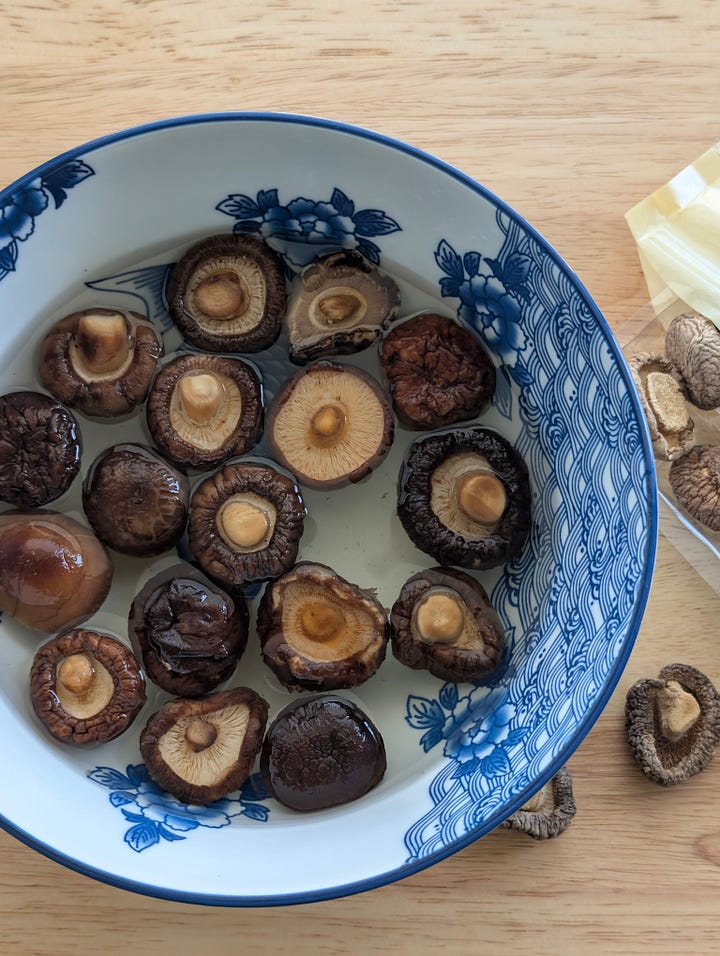
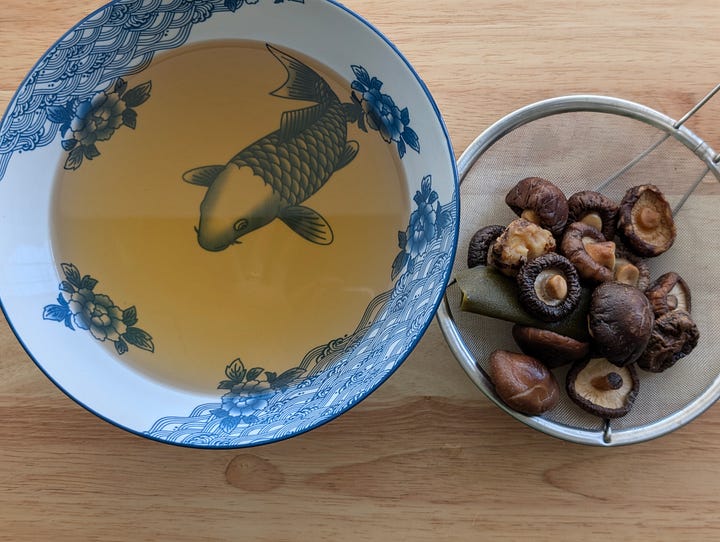
How to Make Shiitake Dashi
Shiitake Dashi
Makes about 4 cups
4 cups warm water
2.5 oz dried shiitake mushrooms
1 (2.5-inch x 2.5-inch) piece of kombu
Method:
Soak the shiitake: Cover the dried shiitake mushrooms with the warm water and allow to soak for 10 minutes. Drain the mushrooms, reserving the soaking water.
Prepare the kombu: Gently wipe the kombu to remove any grit, but be sure to leave the white powdery stuff.
Heat the dashi: Bring the reserved shiitake soaking water to a near boil in a saucepan. Remove from heat and add the kombu and soaked mushrooms.
Steep: Allow to steep for 5 minutes. Strain the liquid, yielding approximately 4 cups of dashi. For the clearest dashi, strain through a cheesecloth.
Tip: The kombu and mushrooms can be reused once more to make a second batch of dashi. Store in the refrigerator for up to 3 days if planning to reuse. Alternatively, use the mushrooms to make Pickled Shiitake Mushrooms. Simmer the kombu in soy sauce to chop and mix into onigiri.
Essential Miso Soup Recipe
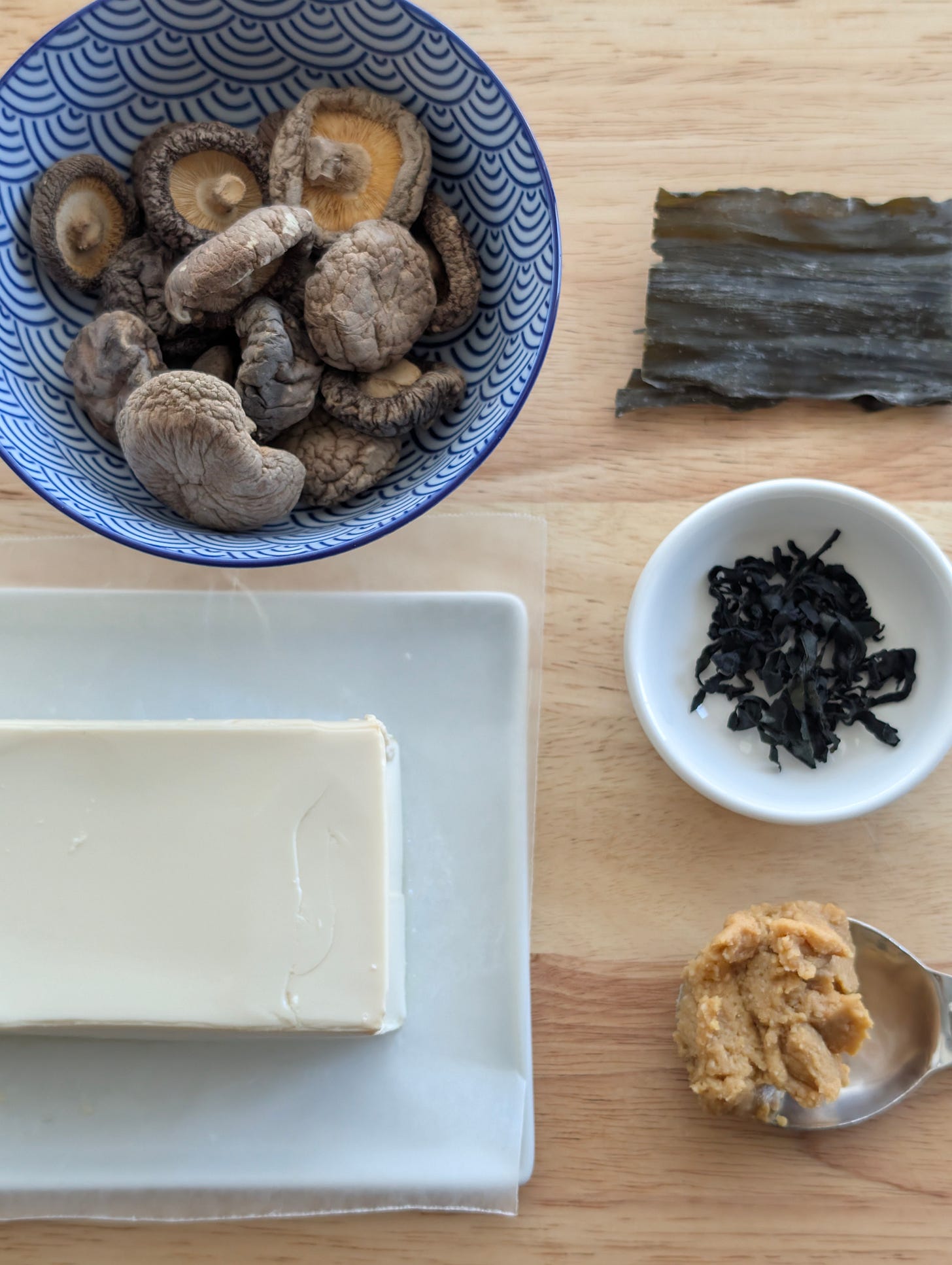
Once you have dashi, making miso soup couldn’t be easier. All it takes is whisking miso paste into the warmed broth. The key is to add the miso just before serving and to keep the soup below a simmer. Boiling the miso can dull its delicate flavor.
This recipe is a simple foundation for miso soup, featuring silken tofu and wakame (a mild, tender seaweed often used in soups). For a springtime twist, toss in your favorite seasonal vegetables. Scroll down for three of my favorite spring-inspired combinations.
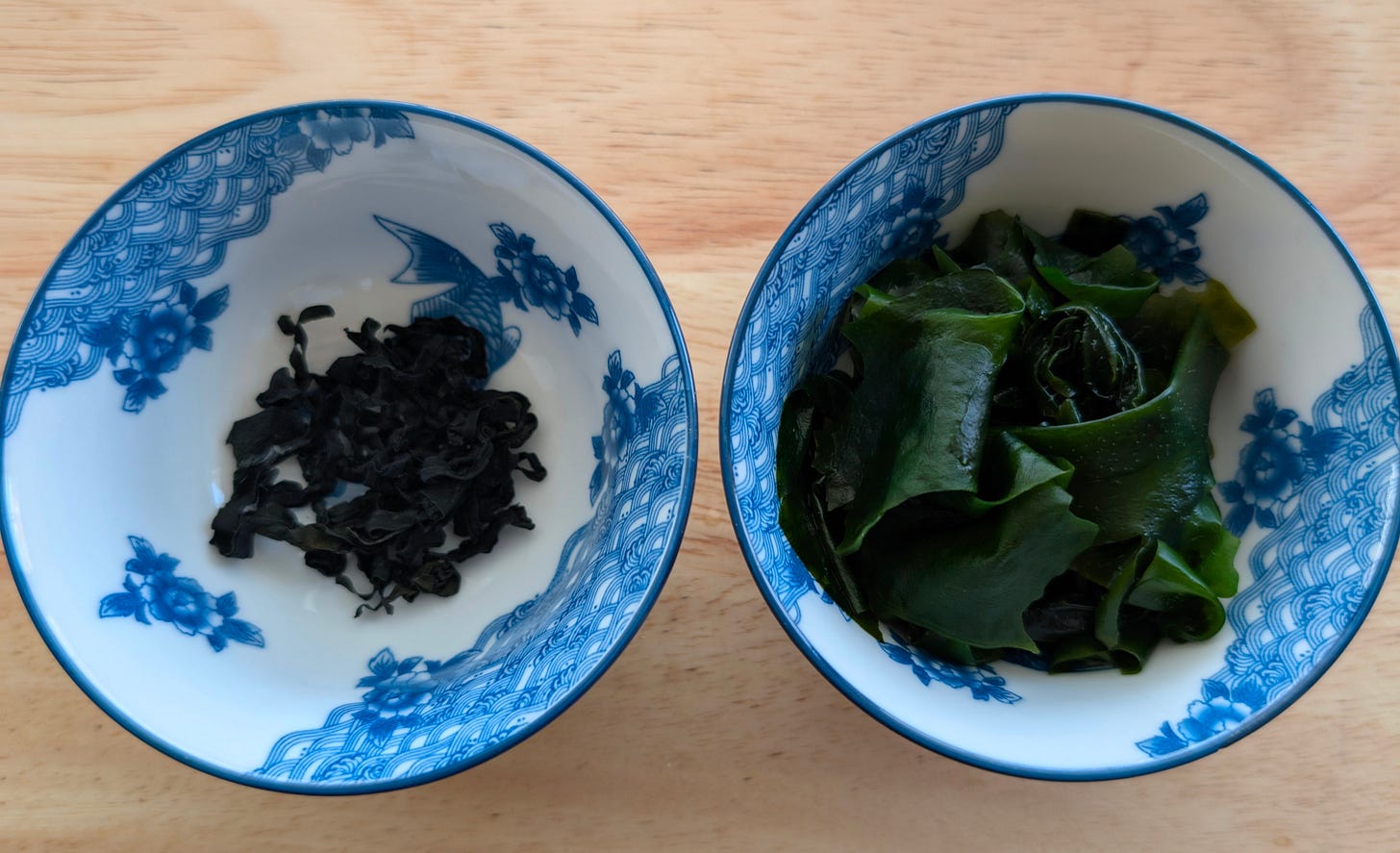
Miso soup is even better when part of a simple, satisfying meal. Pair it with a bowl of steamed rice and a side of tsukemono (Japanese pickles) for a well-rounded, comforting combination of flavors and textures.
Essential Miso Soup Recipe
Makes about 4 servings
Ingredients:
4 cups dashi (Dashi is preferred, but low-sodium vegetable stock may also be used.)
4 tablespoons miso paste (I like white miso for spring and summer.)
1 (12 oz) package silken tofu (cubed)
1 teaspoon dried wakame, optional
Assorted spring vegetables, blanched or prepared
Method:
Rehydrate the wakame: Place the wakame in a small bowl of warm water and allow to soak for 5 minutes, until softened. Drain and set aside.
Pre-blanch the vegetables (optional but recommended):
Bring a separate small pot of water to a boil.
Quickly blanch firmer vegetables like asparagus or snap peas for 30 seconds to 1 minute, then immediately transfer them to ice water to stop cooking.
Delicate greens like baby spinach don’t require blanching and can be added directly.
Heat the dashi: In a saucepan, heat the 4 cups of dashi over medium heat until just before boiling.
Dissolve the miso:
In a small bowl, whisk 4 tablespoons of miso paste with ½ cup of hot dashi until fully dissolved.
Pour the miso mixture back into the pot, stirring gently. Do not let the soup boil after adding miso to preserve its delicate flavors.
Assemble the soup: Add the cubed tofu, wakame, and pre-blanched vegetables to the pot. Simmer gently for 1-2 minutes, just until everything is warmed through.
Serve & Enjoy: Ladle into bowls and enjoy as is, or garnish with scallions, sesame seeds, or a sprinkle of shichimi togarashi.
Spring Miso Soup Combinations to Try
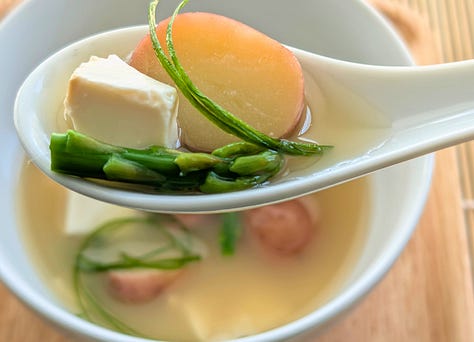

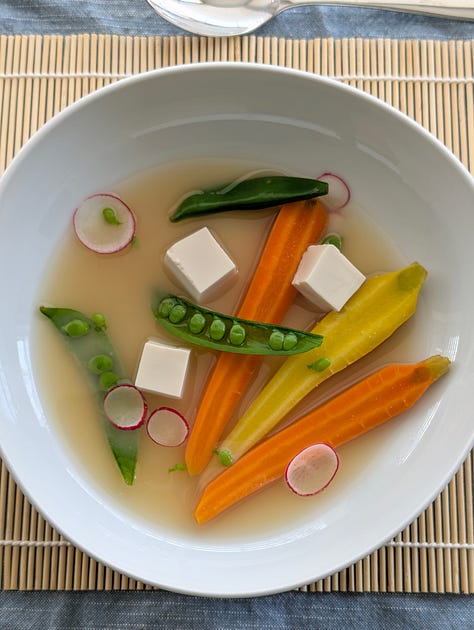
While it’s perfectly delicious on its own, miso soup is also a great canvas for whatever flavors the season brings. Tofu and wakame are classic additions that work in any season, but spring offers a whole new palette to play with from crisp snap peas to new potatoes, or even a surprising touch of rhubarb.
If you’re unsure where to start, here are three of my favorite spring-inspired miso soup combinations to try. No need to follow a strict recipe. Just mix, match, and make it your own!
Snap Peas + Radish + Baby Carrots
A bright and refreshing soup with a bit of crunch from snap peas and radish, balanced by the natural sweetness of baby carrots. For this one, I like to place the vegetables in a shallow bowl and ladle the soup over it.
New Potatoes + Asparagus + Spring Onions
A slightly heartier miso soup where new potatoes add a creamy texture, asparagus brings freshness, and spring onions add a mild oniony bite.
Rhubarb + Shiitake Mushrooms + Spinach
After a quick poach in ginger infused water, rhubarb brings a bright contrast to the deep umami of mushrooms and the silkiness of wilted spinach.
What’s your miso soup style? Do you keep it classic or add your own twist? I always love to hear about what you’re creating.
Free Vegan Bento Box Class
Will I see you this Sunday, March 30th? Chef Adam Sobel of Cinnamon Snail and I are teaching a free live-streamed vegan bento class, and we’d love for you to join us! If you haven’t signed up yet, there’s still time to save your spot!
Sushi with the Culinary Maven
Ever wonder what it’s like to make sushi at home?
Nicole S. (aka the Culinary Maven) recently gave it a whirl using my techniques for making inside-out rolls. She's sharing the whole experience in her amazing Substack, Tuesday Night Dinner Club, a quirky cookbook club full of real talk, recipe trials, and the occasional cat photo.
She’s sharing the full story on March 28, so be on the lookout!
Until then, you can explore her kitchen adventures here: Tuesday Night Dinner Club.









I have this great Asian market nearby and I love walking the aisles. I've slowly tried to learn more about Asian cooking over the years. It's intimidating! I have miso, dried shiitake, and kombu right now so I'm going to make this soup immediately. Thank you!
Ooh love your plating, Marisa - especially the snap pea combo! For the rhubarb combo, do you think shungiku would pair well?